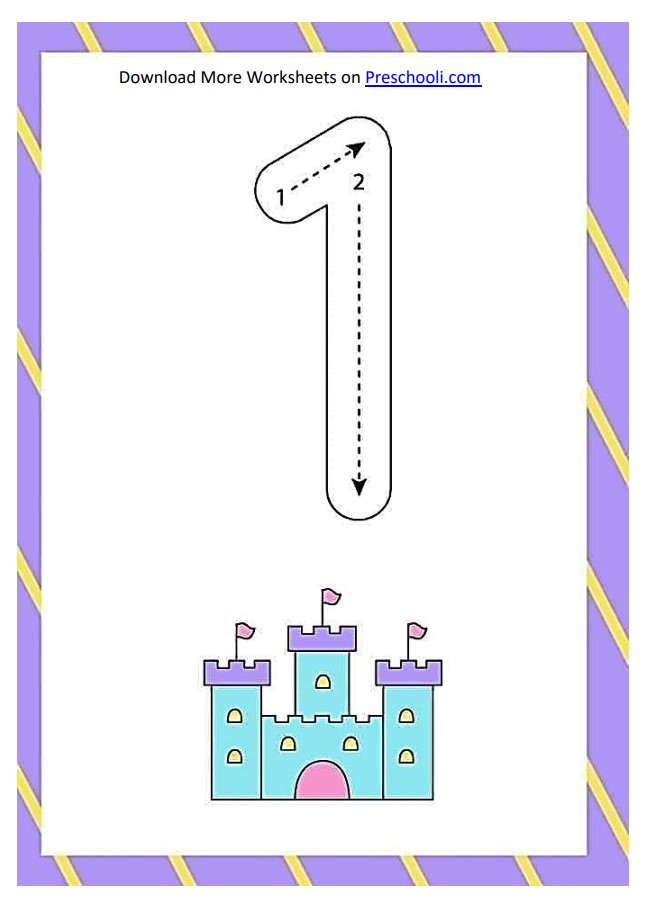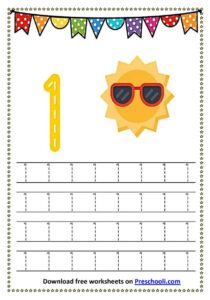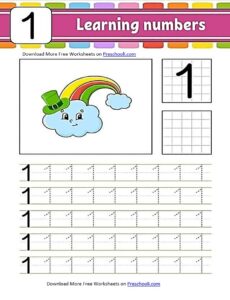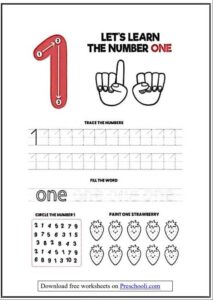The Ultimate Guide to Preschool Number Worksheets: Fun and Educational Practice at Home!
Preschool years are a wondrous time of exploration, learning, and discovery. Here, we dive into the realm of preschool number worksheets—every parent’s and teacher’s handy tool in making foundational math concepts exciting and accessible. From those first wobbly lines to the confident tracing of numbers, these worksheets pave the way for a child’s numerical journey.
Why the Fun of Numbers Begins with Worksheets
Understanding numbers is a significant milestone in early childhood development. What might seem mundane to adults—scribbling in designated spaces, tracing, and coloring—holds a magic of its own for little minds. It’s a venture into the abstract world of quantitative concepts. And when infused with play and color, the essence of numbers is revealed in all its vibrant simplicity
Today, we’re exploring a plethora of preschool number worksheets, designed not only to teach numbers but to make the entire process one of joy and engagement.
The Essentials of Number Recognition
Before we delve into practice sheets and printables, let’s highlight the importance of number recognition. It’s the bedrock of mathematical understanding. At this stage, children aren’t just memorizing shapes; they’re contextualizing quantities. Recognizing numbers helps them count objects, name sequential order, and even solves simple problems
Making it Stick: Tips for Effective Number Recognition
- · Incorporate Everyday Themes: Use numbers in everyday themes—like counting fruits, the number of stairs climbed, or the number of toys put away.
- Multi-Sensory Approach: Tap into auditory, visual, and kinesthetic senses. Sing counting songs, vary the sizes of numbers on worksheets, and manipulate objects to count.
- Repetition and Reinforcement: Repetitive exposure to numbers with different materials and in various activities can boost recognition.
The Advent of Preschool Number Worksheets
As we present these worksheets, we underscore the potential they have to make learning flexible and fun. We’ll cover the following types of activities:
- Tracing Worksheets: Guiding the hand through the formation of numbers.
- Color-by-Number: Pairing numbers with colors for artistic fun.
- Writing Practice: Where the numbers are written, not just traced.
- Counting Sheets: A visual and active component of number understanding.
Tracing Through the Numbers
Tracing worksheets are perfect for refining fine motor skills. They offer a structural approach to forming numbers, allowing children to visualize and follow the strokes.
On the Path to Pen Control
- These sheets are not about perfection but progression. The goal is to move from hesitant tracing to confident replication.
- Varying line thickness can be helpful. Children could start with thicker lines before transitioning to conventional pencil-thin lines for actual writing.
The Colorful World of Numbers
Color-by-number worksheets are a delightful fusion of art and math. They cater to the artistic side of children, making number recognition an outcome of creative expression
Number Fluency with a Splash of Color
- By associating numbers with colors, these worksheets reinforce number recognition in a novel way.
- Their engagement helps in boosting retention, as the child is involved in an enjoyable task.
Writing Numbers: Free on the Dotted Lines
When children take to freeform writing of numbers, it’s a step towards greater autonomy and confidence. The numbers aren’t just mimicked; they’re independently crafted.
Rules for Writing Numbers
- Assist with the form of the numbers without overwhelming the child. Point out where each number “starts” and “ends.”
- Reiteration is key. Show the numbers in different contexts different sizes, positions, and with different manipulatives if possible.
Counting and Writing Go Hand in Hand
Counting sheets help children not only recognize numbers but also understand their value in a visual manner. They connect the abstract symbol to the concept of quantifying.
The Power of Visual Aids
- Use visuals—be it dots, pictures, or simple representations—so that numbers aren’t just something to remember but something to understand.
- Encourage counting out loud or using fingers to tally. This tactile reinforcement can solidify cognitive understanding.
The Secret to Making Worksheets Work
The efficacy of any educational tool lies as much in its usage as in its design. Here’s how you can ensure these preschool number worksheets are making a real impact:
- Consistent Practice: Incorporate these worksheets into regular learning activities.
- Progressive Complexity: As children grow, so should the complexity of the worksheets. Start with a few numbers and build up.
- Feedback and Praise: Always provide positive reinforcement. Encourage effort and improvement, not just the correct answers.
Navigating the Technological Tide: Digital Worksheets
As technology integrates further into education, digital worksheets are gaining momentum. They offer interactive elements, tracking features, and an evergreen quality that printed ones might not.
The Rise of Interactive Learning
- Digital worksheets can offer activities that respond to touches, making them a multisensory experience.
- Feedback mechanisms like sound or color changes can make learning immediate and dynamic.
A Wholesome Approach: Marrying Technology and Touch
For parents and educators wary of screen time, digital worksheets need not be a compromise. Like all tools, their value is in how they’re used. Here’s how to make the most of them:
- Set Limits: Establish time guidelines. Use digital worksheets as a supplement, not a substitute.
- Engage With Your Child: Always co-view the activities. Engage with your child and the content together.
The Inclusive Classroom: Using Worksheets for All Learning Styles
Every child is unique, and so are their learning preferences. Worksheets can be modified to accommodate various learning styles.
Addressing Diverse Learners
- For visual learners, colorful and visually appealing designs are essential.
- Auditory learners might benefit from hearing the numbers being spoken while they work.
- Tactile and kinesthetic learners thrive with interactive elements, such as dragging and dropping or pen-based inputs.
Conclusion: Worksheets, a Path to Number Proficiency
Preschool number worksheets are versatile and vast in their ability to support young learners. They offer structure and yet the freedom to explore the world of numbers at a child’s pace. As we bid adieu, remember that each scribble and traced line is a step towards numerical literacy. Make these worksheets not just a tool but a canvas upon which preschoolers paint their bright and numerically rich futures.
Join us Facebook Group for School decoration ideas and updates



